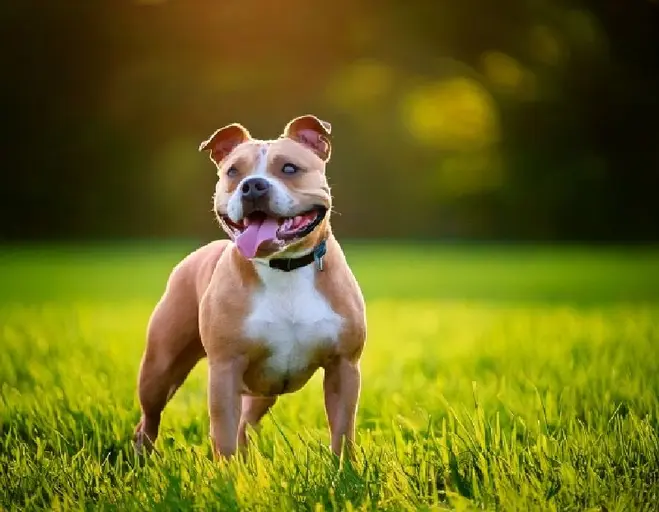The Staffordshire Bull Terrier: Your Comprehensive Guide

Brief Introduction
The Staffordshire Bull Terrier, often affectionately called a “Staffy,” is a compact, muscular, and remarkably courageous breed. Known for its unwavering loyalty and affectionate disposition, the Staffy is a popular choice for families and individuals alike. They possess a powerful build that belies their playful and often comical nature. While they have a rich and somewhat controversial history, modern Staffies are bred for companionship and have become beloved members of households around the globe. What makes them attractive is their combination of strength, resilience, and deep affection for their human families. They are energetic and playful but also enjoy cuddling up for a nap, making them adaptable to various lifestyles.
Breed History
The history of the Staffordshire Bull Terrier is intertwined with the now-banned blood sports of 19th-century England. Tracing back to the “Bull and Terrier” crosses of the time, these dogs were initially bred for bull-baiting and ratting, requiring a combination of strength, agility, and tenacity.
Origins and Development
- The breed’s ancestors were crosses between bulldogs and various terriers, creating a dog that was both strong and agile.
- These “Bull and Terrier” dogs were used in blood sports like bull-baiting and ratting.
- As blood sports were outlawed, the breed began to be refined for companionship.
- In the late 19th century, breeders began to standardize the breed, with the first breed club formed in 1935.
- The Staffordshire Bull Terrier was officially recognized by the Kennel Club (UK) in 1935 and the American Kennel Club (AKC) in 1974.
The refinement of the breed shifted the focus from fighting to companionship. Breeders emphasized temperament, resulting in the loyal and affectionate dogs we know today. Despite their past, responsible breeding practices have worked to minimize aggression and promote a more family-friendly nature.
Appearance
The Staffordshire Bull Terrier is a sturdy and well-muscled dog with a distinctive appearance. Their powerful physique and confident demeanor contribute to their undeniable charm.
Key Physical Characteristics
- Height: Typically 14-16 inches (36-41 cm) at the withers.
- Weight: Ranging from 24-38 pounds (11-17 kg).
- Coat: Short, smooth, and close-lying, requiring minimal grooming. Comes in various colors, including red, fawn, white, black, blue, or any of these colors with white. Brindle is also common.
- Head: Broad and deep skull with pronounced cheek muscles.
- Ears: Rose-shaped or semi-prick ears are preferred, not fully erect or dropped.
- Eyes: Round and medium-sized, ideally dark in color.
- Tail: Medium length, set low, and carried low.
- Body: Compact and muscular, with a broad chest and strong limbs.
Their appearance reflects their historical role as tenacious fighters, but their kind eyes and playful expression hint at the loving companion they can be.
Character and Behavior
The Staffordshire Bull Terrier is known for its courage, intelligence, and, most importantly, its affectionate temperament. Understanding their character is key to providing a suitable and fulfilling home.
Attitude Towards People
Staffies are famously affectionate and loyal to their families. They are often referred to as “nanny dogs” due to their patience and gentleness with children, although supervision is always essential, especially with very young children. They thrive on human interaction and can suffer from separation anxiety if left alone for extended periods.
Attitude Towards Children
As mentioned, Staffies often do well with children, demonstrating remarkable patience and tolerance. However, it’s crucial to teach children how to interact respectfully with dogs and supervise all interactions to ensure safety for both the child and the dog. Early socialization with children is vital to develop positive relationships.
Attitude Towards Animals
The Staffy’s history as a fighting dog can sometimes influence their behavior towards other animals. They may exhibit dog aggression, particularly towards dogs of the same sex. Early and thorough socialization with other dogs and animals is crucial to mitigate this potential issue. Introducing them to other animals gradually and under supervision is recommended. Cat introduction should be carefully monitored.
Activity Level
Staffies are moderately active dogs who need regular exercise to stay physically and mentally stimulated. Daily walks, playtime in the park, and interactive games are essential. They are also intelligent and benefit from mental challenges such as puzzle toys and training sessions.
Trainability
Staffies are intelligent and eager to please, making them generally trainable. However, they can also be stubborn, requiring consistent and positive reinforcement training methods. Early socialization and obedience training are crucial for managing their potential for dog aggression and ensuring they become well-behaved companions.
Breed Characteristics
- Courageous: They are known for their bravery and can be protective of their families.
- Loyal: They form strong bonds with their owners and are fiercely loyal.
- Affectionate: They are incredibly affectionate and enjoy cuddling and spending time with their families.
- Intelligent: They are smart and quick learners, though they can be stubborn.
- Playful: They retain a playful attitude throughout their lives.

Care and Maintenance
Proper care and maintenance are essential to ensure the health and well-being of a Staffordshire Bull Terrier. Understanding their specific needs will help you provide a happy and fulfilling life for your Staffy.
Care Features
Staffies have relatively low-maintenance grooming needs. Their short coat requires only occasional brushing to remove loose hair and keep it shiny. Regular nail trimming, ear cleaning, and dental hygiene are also important aspects of their care routine.
Exercise
They need daily exercise to burn energy and prevent behavioral problems. At least one long walk, coupled with some play time, is recommended. They enjoy activities like fetch, tug-of-war, and agility training.
Feeding
A high-quality dog food appropriate for their age and activity level is essential. Monitor their weight to prevent obesity, a common problem in this breed. Provide fresh water at all times.
Grooming Needs
- Brushing: Occasional brushing is sufficient.
- Bathing: Bathe only when necessary, as frequent bathing can dry out their skin.
- Nail Trimming: Trim nails regularly to prevent overgrowth and discomfort.
- Ear Cleaning: Clean ears regularly to prevent infections.
- Dental Hygiene: Brush their teeth regularly to maintain good oral health.
No haircut is needed for this breed due to its short coat.
Health
Staffordshire Bull Terriers are generally healthy dogs, but they are prone to certain health conditions:
- Hip Dysplasia: A malformation of the hip joint that can lead to arthritis.
- Elbow Dysplasia: Similar to hip dysplasia but affects the elbow joint.
- Hereditary Cataracts: Clouding of the lens of the eye that can lead to blindness.
- L-2-Hydroxyglutaric Aciduria (L-2-HGA): A metabolic disorder that affects the brain and nervous system.
- Demodicosis (Demodectic Mange): A skin condition caused by mites.
Routine veterinary check-ups, a healthy diet, and regular exercise are crucial for maintaining their health.
Breed Weaknesses
While Staffordshire Bull Terriers are wonderful companions, potential owners should be aware of certain breed weaknesses and challenges.
Level of Aggression
As mentioned earlier, Staffies can exhibit dog aggression, particularly towards dogs of the same sex. This stems from their history as fighting dogs. Early socialization and training are essential to minimize this potential issue. Responsible ownership includes managing their interactions with other dogs and being aware of their body language.
Loyalty
Their unwavering loyalty to their families can sometimes translate into protectiveness, which, if not properly managed, can lead to territorial aggression. Proper training and socialization can help them distinguish between genuine threats and harmless situations.
Specific Weaknesses
- Tendency towards dog aggression: Requires careful management and socialization.
- Potential for separation anxiety: Thrives on human interaction and can become anxious if left alone for long periods.
- Stubbornness: Can be stubborn during training, requiring patience and consistency.
- Prone to certain health conditions: Regular veterinary care is crucial.
Conclusion
The Staffordshire Bull Terrier is a loyal, affectionate, and courageous breed that can make a wonderful companion for the right owner. They are best suited for active families or individuals who can provide them with plenty of exercise, mental stimulation, and affection. They need an owner who is prepared to invest time in training and socialization, particularly to manage their potential for dog aggression. If you are looking for a devoted and energetic companion, the Staffordshire Bull Terrier may be the perfect breed for you. However, be prepared to address their specific needs and potential challenges with responsible ownership.
Frequently Asked Questions About Staffordshire Bull Terrier
-
What is a Staffordshire Bull Terrier known for?
Staffordshire Bull Terriers, often called “Staffies,” are known for their courage, loyalty, and affectionate temperament. They are also recognized for their muscular build and playful nature.
-
Are Staffordshire Bull Terriers good with children?
Yes, Staffies are often referred to as “nanny dogs” due to their patience and gentleness with children. However, supervision is always essential, especially with very young children, and children should be taught how to interact respectfully with dogs.
-
Do Staffordshire Bull Terriers require a lot of grooming?
No, Staffies have relatively low-maintenance grooming needs. Their short coat requires only occasional brushing to remove loose hair.
-
How much exercise does a Staffordshire Bull Terrier need?
Staffies are moderately active dogs who need regular exercise to stay healthy and happy. Daily walks, playtime in the park, and interactive games are essential.
-
Are Staffordshire Bull Terriers easy to train?
Staffies are intelligent and eager to please, making them generally trainable. However, they can also be stubborn, requiring consistent and positive reinforcement training methods.
-
What are some common health problems in Staffordshire Bull Terriers?
Some common health conditions in Staffies include hip dysplasia, elbow dysplasia, hereditary cataracts, L-2-Hydroxyglutaric Aciduria (L-2-HGA), and Demodicosis (Demodectic Mange). Routine veterinary check-ups are crucial.
-
Are Staffordshire Bull Terriers aggressive towards other dogs?
Staffies can exhibit dog aggression, particularly towards dogs of the same sex. Early and thorough socialization with other dogs is crucial to mitigate this potential issue.
-
What is the average lifespan of a Staffordshire Bull Terrier?
While not explicitly mentioned in the article, Staffordshire Bull Terriers typically have a lifespan of 12-14 years.
-
Do Staffordshire Bull Terriers need a lot of attention?
Yes, Staffies thrive on human interaction and can suffer from separation anxiety if left alone for extended periods. They need a family who can give them lots of love and attention.
-
What is the best way to manage potential aggression in a Staffordshire Bull Terrier?
Early socialization and training are essential to minimize potential aggression. Responsible ownership includes managing their interactions with other dogs, being aware of their body language, and seeking professional help if needed.

